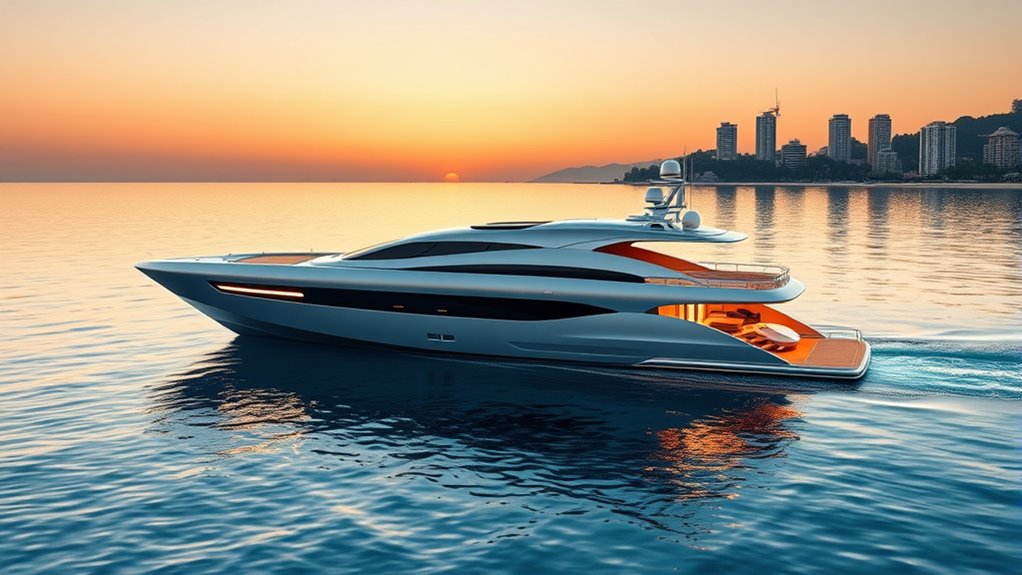Electric superyachts are revolutionizing luxury cruising with eco-friendly technology that reduces emissions, noise, and maintenance costs. Advancements in battery tech and solar integration extend range and enhance onboard sustainability, meeting modern demands for luxury and environmental responsibility. Design innovations optimize space and balance, making these vessels more practical and elegant. While challenges remain, ongoing innovations promise longer ranges and smarter features. Keep exploring to discover how the future of electric superyachts blends luxury with sustainability seamlessly.
Key Takeaways
- Electric superyachts offer sustainable luxury with reduced emissions and eco-friendly materials, aligning with environmental conservation efforts.
- Advances in battery technology enable longer range, faster charging, and seamless energy management for extended cruising.
- Solar integration and energy-efficient hulls enhance onboard sustainability, reducing reliance on fossil fuels.
- Innovations in noise reduction and smart systems improve comfort, safety, and personalized experiences onboard.
- Growing manufacturing solutions and regulatory support accelerate adoption, shaping the future of eco-conscious, high-end maritime travel.
The Rise of Electric Propulsion in Marine Design
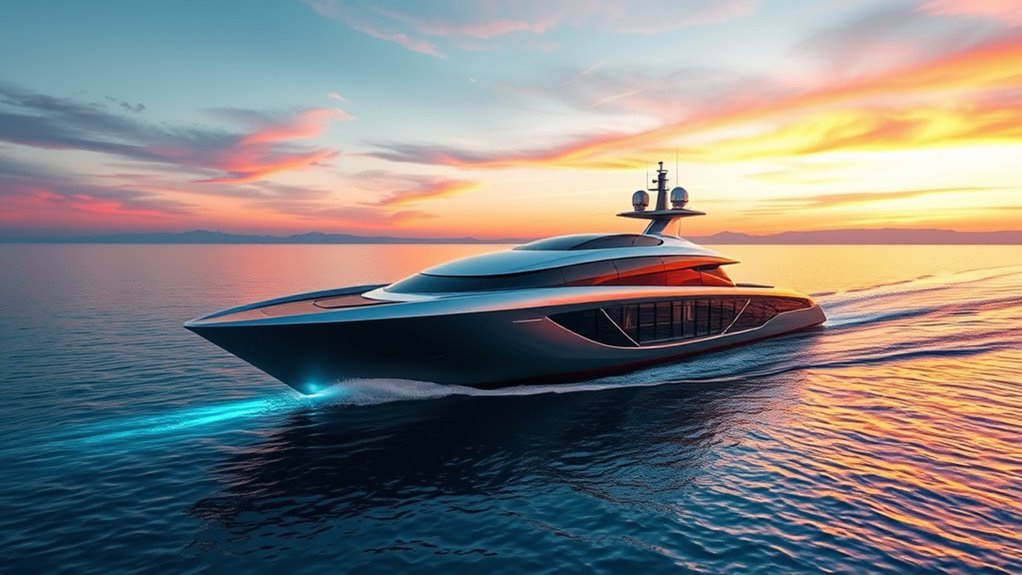
As environmental concerns grow and fuel costs rise, more marine designers are turning to electric propulsion as a sustainable alternative. Advances in battery technology have made electric systems more viable, offering higher energy density and faster charging. You’ll find that design integration now plays a pivotal role; engineers carefully incorporate batteries into the yacht’s structure to optimize weight distribution and balance. This seamless integration allows for more efficient space use, reducing the need for bulky equipment and enhancing overall luxury. Electric propulsion not only lowers emissions but also simplifies maintenance, making it attractive for eco-conscious owners. Additionally, the impact of projector technology on visualization and control systems is increasingly being incorporated into yacht design, providing immersive entertainment experiences onboard. As technology continues to improve, the rise of electric systems marks a significant shift toward greener, more innovative marine design.
Key Features and Innovations of Modern Electric Superyachts
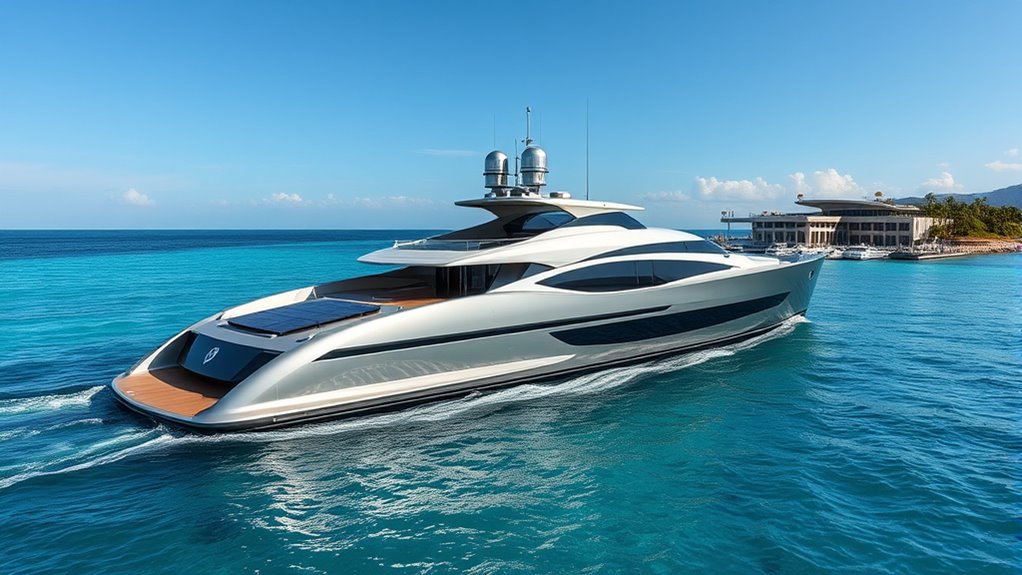
Modern electric superyachts showcase a range of innovative features that set them apart from traditional vessels. One key feature is solar integration, allowing the yachts to harness sunlight to supplement power and extend cruising range. This technology reduces reliance on onboard generators and enhances overall efficiency. Another significant advancement is in battery technology; recent battery advancements provide higher energy density, faster charging, and longer lifespan. These improvements enable longer voyages and more reliable performance without sacrificing luxury. Additionally, sophisticated power management systems optimize energy use, ensuring seamless operation of onboard amenities. Noise reduction technology in heat pumps demonstrates how quieter operation can be achieved without sacrificing performance, an innovation that could inspire quieter systems onboard future electric yachts. Together, solar integration and battery innovations drive the evolution of electric superyachts, making them smarter, more sustainable, and better equipped to meet the demands of modern luxury cruising.
Environmental Benefits and Sustainability Initiatives
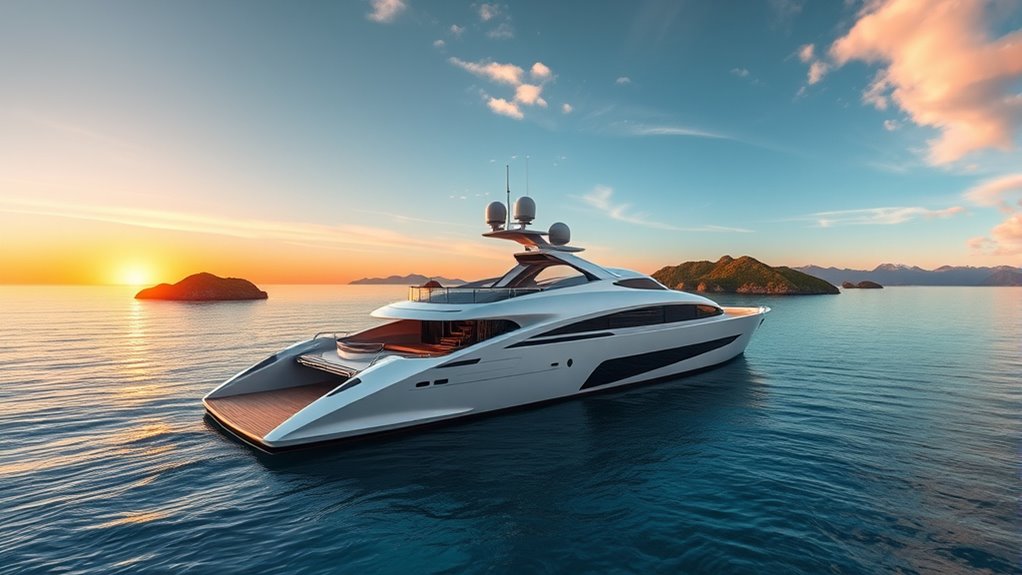
Electric superyachts markedly reduce environmental impact by cutting emissions and decreasing reliance on fossil fuels. They harness renewable energy sources like solar power to supplement battery charging, further minimizing carbon footprints. These yachts often incorporate biodegradable materials in their construction, reducing long-term waste and pollution. Sustainability initiatives also include:
- Using solar panels to generate clean energy onboard
- Implementing biodegradable materials in interior design and furnishings
- Designing energy-efficient hulls and propulsion systems
- Reducing noise pollution for marine life preservation
- Promoting eco-friendly waste management practices
- Integrating raw food preparation methods to minimize food waste and promote sustainability onboard
Challenges and Opportunities in Electric Yacht Manufacturing
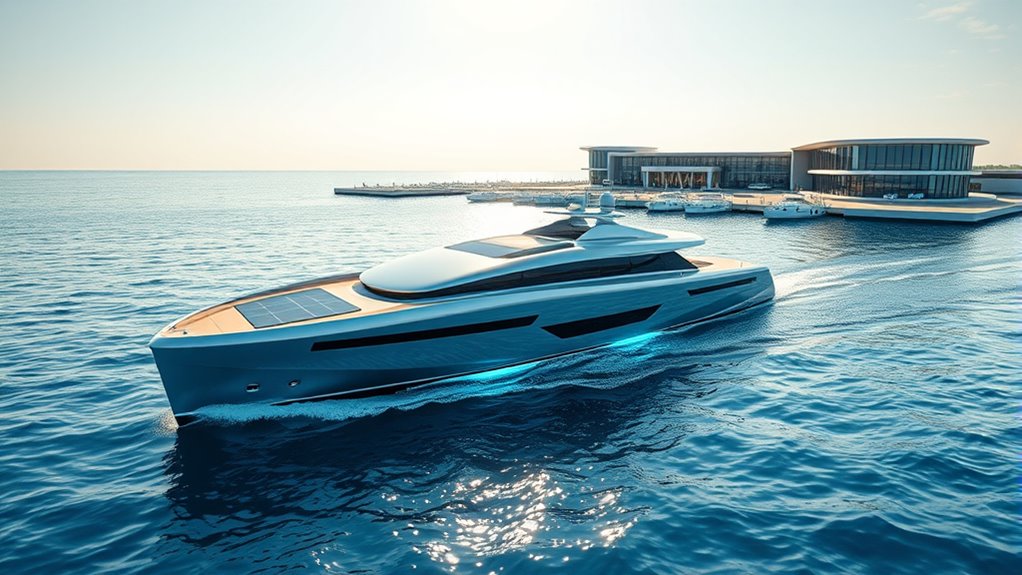
While electric superyachts offer significant environmental benefits, manufacturing these vessels presents a unique set of challenges and opportunities. Battery technology, for instance, is advancing but still faces issues like energy density and long charge times. Regulatory hurdles also complicate production, as standards vary globally and can delay certification. Despite these obstacles, opportunities abound in innovative design and sustainable materials. You can leverage advancements in lightweight composites and modular battery systems to improve efficiency and performance. To better understand these factors, consider this overview:
| Challenge | Opportunity | Key Focus |
|---|---|---|
| Battery technology limitations | Developing high-capacity, fast-charging batteries | R&D investments |
| Regulatory hurdles | Streamlining certification processes | Collaboration with authorities |
| Manufacturing costs | Cost reduction through scalable solutions | Material innovations |
Moreover, addressing manufacturing costs by exploring scalable solutions can significantly accelerate the adoption of electric superyachts.
The Future Outlook: Trends and Predictions for Electric Luxury Vessels
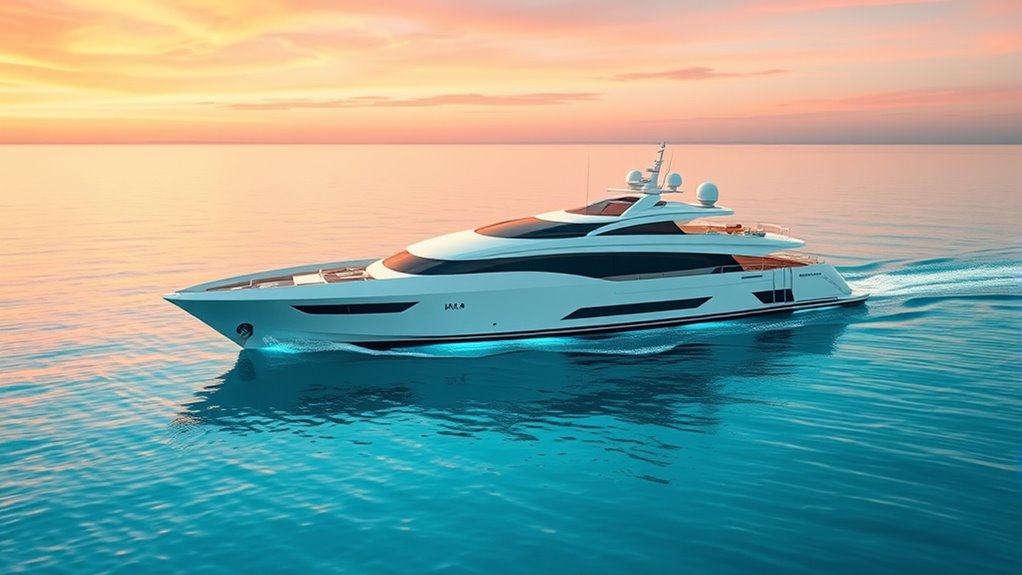
As technology continues to advance rapidly, the future of luxury vessels is increasingly shaped by innovative electric solutions. You can expect autonomous navigation to become standard, enhancing safety and reducing crew needs, while allowing for longer, more efficient voyages. Luxury interior design will evolve with smarter, customizable environments that prioritize comfort and style. Predictably, advances in battery technology will extend range and reduce recharge times, making electric superyachts more practical. Additionally, eco-conscious trends will push for sustainable materials and energy-efficient systems. You might also see increased integration of AI to optimize navigation and onboard management. These developments will redefine the superyacht experience, blending cutting-edge technology with opulent design. Expect a future where electric vessels are smarter, greener, and more luxurious than ever. Wall organization solutions can also play a role in creating sleek, functional onboard spaces.
Frequently Asked Questions
What Are the Maintenance Costs Compared to Traditional Superyachts?
You might wonder about maintenance costs compared to traditional superyachts. Electric superyachts typically have lower repair costs because they lack complex engines and fewer moving parts. However, battery maintenance is essential; batteries need regular checks and eventual replacement, which can be costly. Overall, electric superyachts tend to have reduced ongoing expenses, but you should consider potential battery repair costs when planning your budget for long-term ownership.
How Do Electric Superyachts Perform in Long-Distance Voyages?
You’ll find that electric superyachts perform well on long-distance voyages, thanks to advances in battery longevity. Modern batteries can now store more energy, allowing you to cover greater distances without frequent charging. However, you’ll need to take into account the charging infrastructure along your route, as it’s still developing. Planning your journey around available charging stations ensures smooth sailing, making electric superyachts a viable option for extended trips.
Are There Any Restrictions on Electric Yacht Use in Protected Waters?
You should know that using electric yachts in protected waters often involves restrictions due to marine conservation efforts. Legal regulations aim to preserve delicate ecosystems, so you might face limitations on where you can sail or dock. These rules help minimize environmental impact, ensuring marine life stays healthy. Always check local laws before heading into protected areas, so you stay compliant and support marine conservation.
What Are the Safety Measures for High-Voltage Electric Systems Onboard?
You should prioritize high voltage safety and battery containment onboard your electric superyacht. Proper insulation and secure battery containment prevent electrical faults and fires, while safety systems like circuit breakers and emergency shut-offs protect you from high-voltage hazards. Regular maintenance and safety drills guarantee everyone knows how to respond to electrical issues. These measures keep your journey safe, allowing you to enjoy luxury cruising with peace of mind.
How Do Electric Superyachts Impact Local Marine Ecosystems?
Imagine a gentle ripple in the ocean; electric superyachts can subtly influence marine life and underwater noise. You might not see it, but their quieter engines reduce disruptive sounds, helping protect marine ecosystems. However, their energy sources and potential waste management still pose concerns. By choosing cleaner power options and responsible operation, you help guarantee these vessels coexist harmoniously with marine life, preserving the underwater world for future generations.
Conclusion
Imagine stepping onto an electric superyacht as if entering a sleek, eco-friendly spaceship gliding silently through the ocean. Just as a sailboat harnesses wind and a spaceship relies on advanced technology, these yachts combine innovation and sustainability to lead us into a cleaner, more luxurious future. Embrace this evolution, where every voyage becomes a journey not just of discovery, but of protecting the world’s most precious waters. The horizon is bright for electric luxury cruising.

